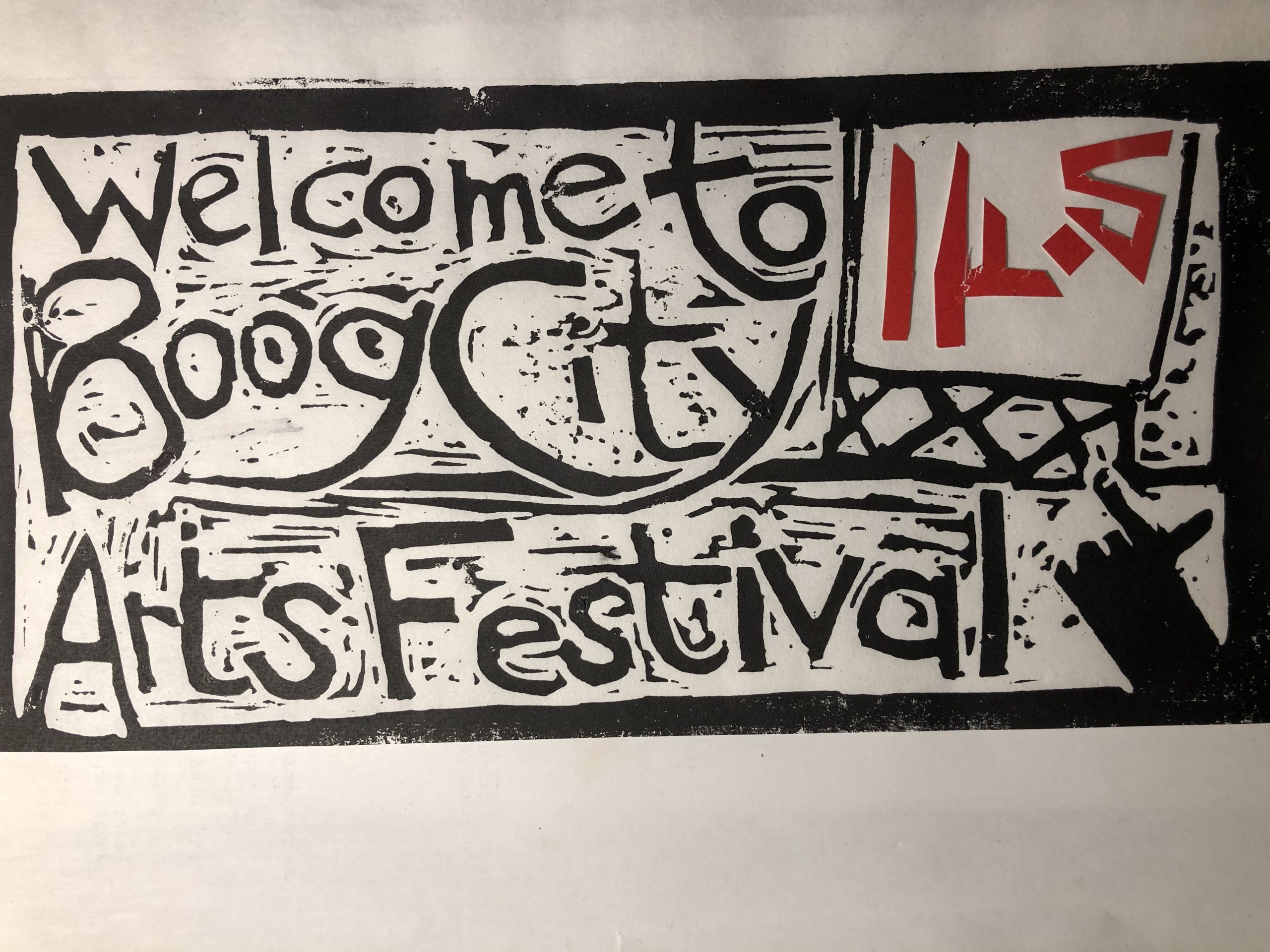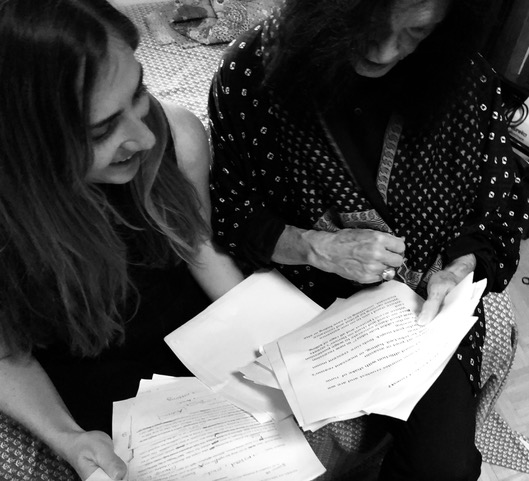Emma Gomis and Anne Waldman.
by Emma Gomis
The first part of our triptych, the panel to the left, is a landscape painted in shades of dark green and bright amber. The darkness, an opacity that cloaks the location, but if we squint we can make out a landscape that melds the dark green ponderosa pines of Colorado with the streets of New York City. MacDougal Street winds away from us toward the mountains where in the distance we can make out a small fire, the embers glowing in the night.
This section of the triptych depicts Anne as a chiaroscuro, the blending of light and dark. Her brightness, which fuels her ability to seriously engage with the political realms head on, not shying away from the darkness but rather kindling the fire that burns and allowing it to spark into its own forms of activism. Anne is associated with various literary movements such as the Beats, New York School, Black Mountain, and other experimental trajectories of American Poetry, but she adds her own twists that are so uniquely hers. For the past six decades, Anne has worked as a feminist, teacher, poet, editor, magpie scholar, powerful performer, and a cultural and political activist. Waldman is, in her words, “drawn to the magical efficacies of language as a political act.” Her version of the political is urgent and necessary, a blending of darkness with light as she looks into your eyes and asks you to get out there and do something.
In the 1970s she was arrested at Rocky Flats with Allen Ginsberg and Daniel Ellsberg for protesting the plutonium “pits” manufactured for the triggers for warheads. This led to a commitment to the accountability for nuclear waste to future generations, a vow that she honors by continuing to register for protests on the contamination at the ghost plant. She continues to engage in political acts. In 2019 she was out protesting at the Arvada Immigrant Detention Center in Colorado and drove down to El Paso to protest at the border.
We can also see her political engagement in all of her over 40 books of poetry. Her latest book, Trickster Feminism, summons a powerful kind of political magic. Anne is a cunning rule breaker, positioned disruptively outside of conventional mores, working against capitalism, against the patriarchy. Her career defies political and poetic convention, in favor of feminist mischief and playfulness. Her work as a cultural and political activist is enmeshed with her poetry.
Her practice in Tibetan Buddhism is also inextricably connected to her poetry, which brings me to the second triptych on the right. This one depicts a bird, its wings spanning the length of the entire panel. The New York Times has called Anne a “combination of oracle, siren and den mother.” No one can deny that there is some alluring magic to this bird. The way she hovers and shimmers, the light hitting her feathers at different angles. In Trickster Feminism Anne tells of a woman “mumbling mantras … as she circles the tower. … Om Man Be Gone … Om Con Con Be Gone.”
She incorporates ritual and rhizomic meditations into her words. The performance of her work is engaging and physical, often including chant or song. She remains a highly original “open field investigator” of consciousness, committed to the possibilities of radical shifts of language and states of mind to create new modal structures and montages of attention. In Voice’s Daughter of a Heart Yet To Be Born (2016), which, as Lyn Hejinian says, “brings Waldman’s work into the more intimate paradoxical folds of poetic (and prophetic) knowledge,” Anne appropriates the idea of Blake’s unborn spirit of Thel to explore artists’ and activists’ roles during the Anthropocene.
A bird can also fly, and so Anne seems to be everywhere at once. She has worked at the Institute of American Indian Arts in Santa Fe and at the Women’s Christian College in Tokyo. She has presented her work at conferences and festivals around the world, most recently in Jaipur, Bratislava, Wuhan, Beijing, Berlin, Nicaragua, Prague, Kerala, Mumbai, Calcutta, Marrakech, and Madrid. Her work has been translated into numerous languages. She has recently been teaching in Morocco, collaborating with the Taamas foundation and in Oaxaca and in Mexico City where she gave a poetry workshop at a women’s prison with the initiative Rizoma.
All of this while somehow finding time to still keep writing more books, the next of which will be Bard Kenetic, as well as a libretto for an opera with music by David T. Little telling a story which constellates around William S. Burroughs and David Lynch.
In the third and central panel of our triptych we find an angel, and by angel I mean something like the sycamore tree, or an aspen grove with its rhizomatic roots. This is the side of Anne that is teacher and mentor, the side that is committed to keeping the world safe for poetry.
Her commitment to poetry extends beyond her own work to her support of alternative poetry communities. She has collaborated extensively with visual artists, musicians, and dancers. She often collaborates and with her son, musician and composer Ambrose Bye and nephew Devin Waldman. She has just recently released an album called Sciamachy, a word that means shadow war, which Patti Smith has called “a psychic shield for our times”. The album features Laurie Anderson, Deb Googe (of My Bloody Valentine and Primal Scream), and free jazz legend William Parker, among others.
Her deep commitment to her students manifests in her always encouraging us to keep writing, and to keep pursuing our thinking, always inquiring about our most recent projects and offering advice along the way.
In 1965 Anne attended the Berkeley Poetry Conference, where the Outrider voices she encountered inspired her to commit to poetry and to found Angel Hair with Lewis Warsh, a small press that published a magazine and numerous books. She returned to New York and was one of the founders and directors, of The Poetry Project at St. Mark’s Church, a role she continued for a decade and where she worked with poets including Ted Berrigan, Allen Ginsberg, and Diane di Prima, among others. In 1974, with Ginsberg, Anne founded the Jack Kerouac School of Disembodied Poetics at the Naropa Institute in Boulder, Colo., the first Buddhist inspired University in the western hemisphere. It was here that we met and fostered a deep friendship as well as a collaborative relationship, currently working on two cowritten chapbooks and coediting an anthology from the Naropa Archives titled New Weathers forthcoming on Nightboat Books.
Anne is a recipient of the Before Columbus Foundation for Lifetime Achievement, bestowed on her by Ishmael Reed, the Dylan Thomas Memorial Award, the National Literary Anthology Award, American Book Award’s Lifetime Achievement, a 2013 Guggenheim Fellowship, the Poetry Society of America’s Shelley Memorial Award, and was elected and served six years as a chancellor of The Academy of American Poets. The Huffington Post named her one of the top advocates for American poetry. She was also a “poet in residence” with Bob Dylan’s famed concert tour, the Rolling Thunder Revue, in 1975–76, stay tuned for a movie coming out soon. And has received grants from the Foundation for Contemporary Performance Arts, the Poetry Foundation, and the National Endowment for the Arts.
I could go on but suffice it to say that she is a counter-cultural giant, and also a generous inspiration to us all.
Emma Gomis (www.emmajanegomis.com) is a Catalan American essayist, poet, editor, and translator. Her texts have been published in Denver Quarterly, Entropy, Asymptote, Vice Magazine, and Mother Jones, among others and her chapbook Canxona is forthcoming from b l u s h lit. She is the cofounder of Manifold Press, which publishes texts in experimental criticism. She holds an M.F.A. in creative writing and poetics from Naropa University’s Jack Kerouac School of Disembodied Poetics, where she was also the Anne Waldman Fellowship recipient. She will be pursuing a Ph.D. in criticism and culture at the University of Cambridge in October 2020. Ed Bowes photo.


